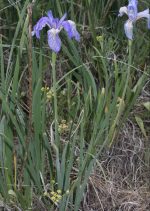 Also called Rocky Mountain iris and Missouri flag, this beardless rhizomatous iris is a member of the iris family, Iridaceae that also includes gladiola, crocus, and freesia. It is native to western and central US from North Dakota to British Columbia south to California and New Mexico where it grows in wet and marshy soils in the valleys to the mountains. Plant grow 1-2′ tall and have grayish-green leaves that are tough and sword shaped. From late spring to early summer leafless stems bear 1-4 flowers that are pale to dark lilac purple with yellow bases, often with purple veins. Each flower is 1-3′ long and has 3 erect petals and 3 spreading to reflexed petal-like sepals that are broader and have a central dark yellow-orange stripe surrounded by diverging blue lines on a white background. The genus name, Iris, is the name of the Greek goddess of the rainbow and refers to the many colors of the flowers. The specific epithet, missouriensis, refers to the Missouri River where Lewis and Clark first collected the plant.
Also called Rocky Mountain iris and Missouri flag, this beardless rhizomatous iris is a member of the iris family, Iridaceae that also includes gladiola, crocus, and freesia. It is native to western and central US from North Dakota to British Columbia south to California and New Mexico where it grows in wet and marshy soils in the valleys to the mountains. Plant grow 1-2′ tall and have grayish-green leaves that are tough and sword shaped. From late spring to early summer leafless stems bear 1-4 flowers that are pale to dark lilac purple with yellow bases, often with purple veins. Each flower is 1-3′ long and has 3 erect petals and 3 spreading to reflexed petal-like sepals that are broader and have a central dark yellow-orange stripe surrounded by diverging blue lines on a white background. The genus name, Iris, is the name of the Greek goddess of the rainbow and refers to the many colors of the flowers. The specific epithet, missouriensis, refers to the Missouri River where Lewis and Clark first collected the plant.
Type: Herbaceous perennial
Bloom: Lilac purple with yellow and white markings in late spring to early summer
Size:1-2′ H x 8-12″ W
Light:Full sun to part shade with afternoon shade in hot climates
Soil:Average, medium moist to wet; moisture more critical before bloom time.
Hardiness: Zones 3-8
Care: Low maintenance
Pests and Diseases:Root rots, leaf spot, mosaic virus, aphids, borers, slugs, snail, thrips, and whiteflies
Propagation: Division in fall and winter
Companion Plants: Parry’s primrose, queen’s crown, elephant’s head, rose paint brush
Photo Credit: Wikipedia